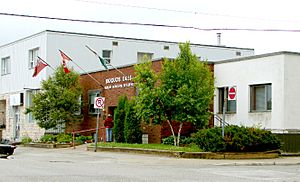Iroquois Falls facts for kids
Quick facts for kids
Iroquois Falls
|
|
|---|---|
|
Town
|
|

Iroquois Falls municipal office
|
|
| Country | |
| Province | |
| District | Cochrane |
| Established | 1912 |
| Incorporated | 1915 |
| Government | |
| • Type | Town |
| Area | |
| • Land | 599.43 km2 (231.44 sq mi) |
| Population
(2006)
|
|
| • Total | 4,729 |
| • Density | 7.9/km2 (20/sq mi) |
| Time zone | UTC-5 (EST) |
| • Summer (DST) | UTC-4 (EDT) |
| Postal code span |
P0K
|
| Area code(s) | 705 |
| Website | Town of Iroquois Falls |
Iroquois Falls is a town in Northern Ontario, Canada, with a population of 4,595 at the 2011 census.
The town centre lies 11 km east of Hwy 11 on the banks of the Abitibi River, west of Lake Abitibi. Timmins, one of the largest cities in northern Ontario, is approximately 70 kilometres (43 mi) to the southwest. The following communities are also within the municipal boundaries: Monteith, Nellie Lake, and Porquis Junction.
Iroquois Falls' primary industry was a large mill producing newsprint and commercial printing papers. In December 2014, the owner, Resolute Forest Products, announced its permanent closure. There are also three hydro-electric dams nearby. The Monteith Correctional Complex, a provincial prison serving a regional catchment area, is located in the community of Monteith (named for Samuel Nelson Monteith).
History
Iroquois Falls was built as a company town by Frank Harris Anson, owner of the Abitibi Power and Paper Company. Anson had been influenced by the garden city movement of urban planning, and was committed to building an elaborate town. A Chicago architectural firm was hired to design the landscaping and houses, and work crews began clearing land in 1913. The town's park and commercial developments were clearly separated from the paper mill, and the residential streets curved with a focus on the center of the town. A large church was built, the first English Catholic Parish in Northern Ontario, and today remains a historic landmark. Anson's company town had a hospital, a school, and a company hotel. Employee homes were designed with gambrel roofs to resemble New England farmhouses, and their design and location reflected the employee's rank at the mill. Papermakers lived in double-adjoined homes, while senior managers lived on separate streets in single-family homes.
Much of the town was destroyed by fire in 1916, though Anson continued his beautification program during the 1920s as the community rebuilt. The town's avant-garde style earned it the nickname "Anson's Folly". The paper mill created a dramatic change to the area, and people migrated to the community for work. The creation of the Temiskaming and Northern Ontario Railway (now Ontario Northland Railway) greatly boosted the economy as there were few roads at the time.
Images for kids








